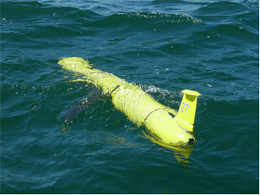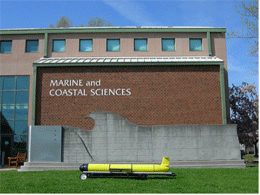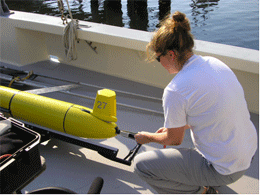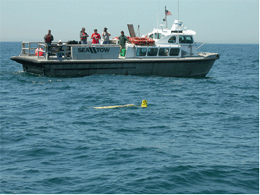Tiny Glider Swims Big
Air Date: Week of June 12, 2009

RU-27 starts its underwater journey. (Photo: Rutgers University)
A remote-controlled underwater robot is probing the ocean for clues about the impact of climate change. The six foot glider called RU27 was launched by students and scientists from Rutgers University in New Jersey. If all goes well, RU27 is expected to stay at sea for seven months, traveling 3,000 miles to Spain, and sending back data every six hours. IEEE Spectrum’s Ari Daniel Shapiro reports on the challenging voyage.
Transcript
CURWOOD: It’s Living on Earth. I’m Steve Curwood.
YOUNG: And I’m Jeff Young.
A team of students and professors from Rutgers University recently launched a project they hope will make seagoing history by remote control. They're sending a little underwater robot across the Atlantic from New Jersey to Spain to learn more about changes affecting our seas. IEEE Spectrum’s Ari Daniel Shapiro was there.
[BIRD SOUNDS]
SHAPIRO: At six in the morning just as dawn was breaking, Scott Glenn, an oceanographer at Rutgers University, was bristling with excitement.
GLENN: Yes, this is a big day. The launch of one of these long duration missions is something you work for for months. And when it’s finally there, it starts a whole new phase of the project. And so, it’s about to start a great day.
[SOFT CHATTER]
SHAPIRO: Glenn’s talking about the launch of the glider RU27. This underwater robot looks like a mini yellow submarine and it’s about six and a half feet long. It can stay at sea for months because it has no people onboard. It’s piloted remotely from a lab at Rutgers, on shore. RU27 zigzags slowly up and down underwater, taking the temperature of the ocean and measuring how salty it is, among other things. Every time the glider surfaces, it uses a global cell phone to call the lab – literally – to send in the data it’s collected and receive instructions on where to go next. The information it’s collecting might tell us something about the impact of climate change on the ocean.

RU-27, developed by researchers at Rutgers University, is an underwater robot that collects oceanic data. (Photo: Rutgers University).
SHAPIRO: Later that morning, Glenn and part of the glider team were on a boat headed off the coast of New Jersey to do the launch.
GLENN: Gliders are changing the way we go to sea. I used to come out of this field station and we’d spend the whole day and we’d do maybe five stations. It would take us all day to do that. We’d come back exhausted. Now we send out a robot to do the same thing. And instead of going out for one day, it’s gonna go out for nine months.
SHAPIRO: If successful, RU27 will be the first remote controlled object to cross an ocean underwater. The route: New Jersey to Spain. A team of Rutgers undergrads will be the ones piloting RU27 from the lab on shore; using everything they’ve learned about currents and the oceans to make the mission a success.
[LAB SOUNDS]
SHAPIRO: Back in the lab, sophomore and RU27 co-pilot Emily Ragowski says she’s excited about the launch.
RAGOWSKI: It’s a big day but honestly, it like – it’s time. RU27 needs to get out there. We’ve been working on her for sooo long. I feel like it’s time for her to start this mission.

Tina Haskin, a technician in the Coastal Ocean Observation Laboratory at Rutgers' Institute of Marine and Coastal Sciences, works with the RU-27 on the day of its launch. (Photo: Rutgers University).
[SPEAKER PHONE DRONE]
SHAPIRO: When the speakerphone announced the glider had been lowered into the Atlantic, the lab honored the moment.
SPEAKER PHONE: Alright, she’s free. She’s off.
[APPLAUSE]
SHAPIRO: The same jubilation erupted aboard the boat.
GLENN AND OTHERS: Good job, good job, good job. You guys build good gliders!

RU-27 starts its underwater journey. (Photo: Rutgers University)
HASKINS: Yeah, the first test – she just didn’t dive fast enough. We should’ve seen her kind of start to descend a little more quickly than what we did.
[LAB SOUNDS]
SHAPIRO: Haskins wondered whether there was a weight missing in RU27. She phoned the lab to ask if they had found anything suspiciously heavy lying around.
LAB: I don’t see anything there. The room’s nice and clean.
[BOAT SOUNDS]
SHAPIRO: In the end, the team figured out there was actually a typo in the mission they programmed. Scott Glenn says RU27 was just following orders.
GLENN: It’s nice that it does exactly what it’s told, even if it’s wrong. It’s probably fine. We’ll find that out soon.
[LAB SOUNDS]
SHAPIRO: And RU27 was fine. The boat team finished their tests, made some last minute adjustments, and transferred control of the glider to shore. Back at the lab, the team waited for the glider to surface and make its first data phone call.
LAB: Oh, there it is! Ahh!
[BOAT SOUNDS]
SHAPIRO: As the folks in the lab finished their tests, they got ready to send the glider underwater to begin its mission. Those on the boat looked at RU27 bobbing at the surface one last time.
HASKINS: Alright, bid farewell! She’s going. This is the last time we’ll see her on the surface for a while!

Researchers glimpse RU-27 before the glider plunges underwater. (Photo: Rutgers University)
SHAPIRO: Scott Glenn’s excitement endured, even through this exhausting day. The kids go out on their own – they’re ready to go, they’re ready to fly.
[LAB SOUNDS]
SHAPIRO: The seven-month journey is not without danger. Severe weather like hurricanes could damage RU27 or blow it way off course. Sharks might attack it. And it’s got limited battery power to make the voyage. Oscar Schofield’s an oceanographer at Rutgers.
SCHOFIELD: And now, what we’ll do, is when it starts its standard mission, it calls in every six hours. And pretty much everyone’s gonna be hanging on a phone call every six hours for the next seven months. But that’s calmer than it’s been the last few months.
SHAPIRO: I’m not sure it’s gonna be that much calmer. In RU27’s first week at sea, the team had to maneuver around a maze of fishing nets and deal with a sensor malfunction. And that was just the first 100 miles, of 3000.
For Living on Earth, I’m Ari Daniel Shapiro.
YOUNG: And that story comes to us courtesy of Spectrum Radio, the broadcast edition of IEEE Spectrum, the magazine of technology insiders. You can follow the sub's journey online - details at loe.org.
[MUSIC] Andrew Bird “The Trees Were Mistaken” from Soldier On (Wegawam Music 2006)
Links
Living on Earth wants to hear from you!
Living on Earth
62 Calef Highway, Suite 212
Lee, NH 03861
Telephone: 617-287-4121
E-mail: comments@loe.org
Newsletter [Click here]
Donate to Living on Earth!
Living on Earth is an independent media program and relies entirely on contributions from listeners and institutions supporting public service. Please donate now to preserve an independent environmental voice.
NewsletterLiving on Earth offers a weekly delivery of the show's rundown to your mailbox. Sign up for our newsletter today!
 Sailors For The Sea: Be the change you want to sea.
Sailors For The Sea: Be the change you want to sea.
 The Grantham Foundation for the Protection of the Environment: Committed to protecting and improving the health of the global environment.
The Grantham Foundation for the Protection of the Environment: Committed to protecting and improving the health of the global environment.
 Contribute to Living on Earth and receive, as our gift to you, an archival print of one of Mark Seth Lender's extraordinary wildlife photographs. Follow the link to see Mark's current collection of photographs.
Contribute to Living on Earth and receive, as our gift to you, an archival print of one of Mark Seth Lender's extraordinary wildlife photographs. Follow the link to see Mark's current collection of photographs.
 Buy a signed copy of Mark Seth Lender's book Smeagull the Seagull & support Living on Earth
Buy a signed copy of Mark Seth Lender's book Smeagull the Seagull & support Living on Earth

